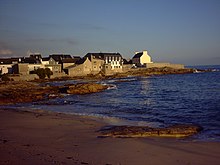Ploemeur
|
Ploemeur Plañvour |
||
|---|---|---|

|
|
|
| region | Brittany | |
| Department | Morbihan | |
| Arrondissement | Lorient | |
| Canton | Ploemeur (main town) | |
| Community association | Lorient agglomeration | |
| Coordinates | 47 ° 44 ′ N , 3 ° 26 ′ W | |
| height | -1-55 m | |
| surface | 39.72 km 2 | |
| Residents | 17,853 (January 1, 2017) | |
| Population density | 449 inhabitants / km 2 | |
| Post Code | 56270 | |
| INSEE code | 56162 | |
| Website | www.ploemeur.com | |
Ploemeur , including Ploemeur (on Breton Plañvour ) is a French municipality with 17,853 inhabitants (1 January 2017) in the department of Morbihan in the region of Brittany . It belongs to the Arrondissement of Lorient , is the administrative seat of the canton of Ploemeur and a member of the Lorient Agglomération municipal association .
geography
The place is four kilometers west of Lorient , six kilometers northwest of Larmor-Plage and eight kilometers southeast of Guidel-Plages on the route Départementale D 162. The city center is in the hinterland of the Côte des Mégalithes . With Lomener, Le Pérello and Fort Bloqué , several coastal villages also belong to Ploemeur. In the east, the Ter , a small tributary of the Blavet, borders the municipality. Ploemeur does not have its own rail link. Lorient Airport is located in the northern part of the municipality .
Population development
| year | 1793 | 1846 | 1872 | 1901 | 1931 | 1946 | 1962 | 1975 | 1990 | 2007 |
| Residents | 5,546 | 7,840 | 10,037 | 9,713 | 8,039 | 7,299 | 6,404 | 9,565 | 17,637 | 18,509 |
Ploemeur was reduced to Keryado (today a district of Lorients) in 1901 and Larmor-Plage in 1925.
History and economy
As many remnants of the megalithic culture show, the area around Pleumeur was already settled in the Neolithic . After Christianization , the first women's monastery in Aremorica was built there at the Étang de Lannénec in the 5th century, made possible by a donation of land , managed by the later canonized Ninnoc ; it was destroyed in one of the Viking raids during the Frankish era . In the High Middle Ages a settlement developed there in the dominion of Kemenet-Héboé , the westernmost part of the county of Vannes , which reached as far as the Laïta ; The Lorients area also belonged to the (church) community of Ploemeurs at the time. In 1666, the French East India Company established its branch in Faouëdic on the Blavet estuary. In 1748, construction of Fort Bloqué, also known as Fort de Keragan, began near the stretch of coast where British troops had landed two years earlier during the War of the Austrian Succession .
As in most of the region's coastline, fishing and processing played an important economic role in Ploemeur. In the summer of 1896 it was one of the centers of the Brittany-wide strike in this branch of the economy. From the beginning of the 20th century, the rich kaolin deposits in the municipality were mined in a quarry. The place was connected to the Lorient tram . In 1920 the Kerpape light bath was built , which was expanded into a rehabilitation center for the disabled after the Second World War ; The European wheelchair basketball championships were held several times in this facility during the 1970s . The expansion of the civilian and, in parts, military ( naval aviation ) airport as well as the immediate vicinity of Lorient, in particular in the last quarter of the 20th century, meant that Ploemeur developed into a rapidly growing “ sleeping city ”.
Attractions
See also: List of Monuments historiques in Ploemeur
- Château de Soye (18th century)
- Château du Ter
- Fort Bloqué
- St. Pierre Church (12th century)
- Rectory (18th century)
- Menhirs (Saint Maudé, Courégant, Kerroc'h, Pen-Palud)
- Dolmen du Cruguellic and Ar Roc'h Penher
Chapels:
- Notre-Dame de la Garde (15th century)
- Sainte-Anne, built in the 16th century ( Monument historique )
- Saint-Thual (17th century)
- Saint-Maudé (17th century)
- Saint-Léonard (17th century)
- Saints-Simon-et-Jude (17th century)
Town twinning
Town partnerships exist with the Belgian municipality of Diksmuide , the Irish Fermoy and Nowa Dęba (Poland).
Personalities
- Henri Dupuy de Lôme (1816–1885), naval engineer and politician
- Louis Le Hunsec (1878–1954), Bishop ( Spiritan ) of the Archdiocese of Dakar
- Nathalie Appéré (* 1975), politician
- Élodie Guégan (* 1985), middle distance runner
- Yoann Gourcuff (* 1986), soccer player
literature
- Le Patrimoine des Communes du Morbihan. Flohic Editions, Volume 2, Paris 1996, ISBN 2-84234-009-4 , pp. 646-651.
Evidence and Notes
- ↑ before 1962 according to Cassini , from 1962 according to INSEE
- ^ Joël Cornette: Histoire de la Bretagne et des Bretons. Seuil, Paris 2005, ISBN 978-2-7578-0995-2 , Volume 2, pp. 328ff.
Web links
- Official community website
- Private page about the history and sights of Ploemeur

